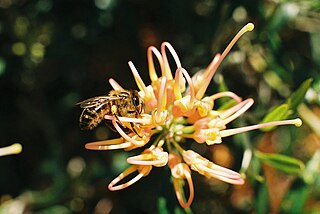Related Research Articles

The scarlet tanager is a medium-sized American songbird. Until recently, it was placed in the tanager family (Thraupidae), but it and other members of its genus are now classified as belonging to the cardinal family (Cardinalidae). The species' plumage and vocalizations are similar to other members of the cardinal family, although the Piranga species lacks the thick conical bill that many cardinals possess. The species resides in thick deciduous woodlands and suburbs.

Mountain coatis are two species of procyonid mammals from the genus Nasuella. Unlike the larger coatis from the genus Nasua, mountain coatis only weigh 1.0–1.5 kilograms (2.2–3.3 lb) and are endemic to the north Andean highlands in South America.

The olive ridley sea turtle, also known commonly as the Pacific ridley sea turtle, is a species of turtle in the family Cheloniidae. The species is the second-smallest and most abundant of all sea turtles found in the world. L. olivacea is found in warm and tropical waters, primarily in the Pacific and Indian Oceans, but also in the warm waters of the Atlantic Ocean.

The western mountain coati or western dwarf coati is a small procyonid, found in cloud forest and páramo at altitudes of 1,300–4,250 metres (4,270–13,940 ft) in the Andes of Colombia and Ecuador. A population discovered in the Apurímac–Cuzco region of southern Peru has tentatively been identified as the western mountain coati, but may represent an undescribed taxon.

Gastrophryne olivacea, the Great Plains narrow-mouthed toad or western narrow-mouthed toad, is a species of microhylid frog found throughout much of the south-central United States from Nebraska south through Texas, and into northern Mexico. Though not a true toad, it is often referred to as such because it is terrestrial.

The olive ibis is a species of ibis native to dense tropical forests in central Africa. Between 65 and 75 cm in length, it is a small ibis with predominantly olive plumage with iridescent sheen. Four subspecies are recognized.

The olive sunbird is a species of sunbird found in a large part of Africa south of the Sahel. It prefers forested regions, and is absent from drier, more open regions such as the Horn of Africa and most of south-central and south-western Africa. It is sometimes placed in the genus Nectarinia.

The brown-tailed mongoose, brown-tailed vontsira, Malagasy brown-tailed mongoose, or salano is a species of mammal in the family Eupleridae. It is endemic to Madagascar. Its natural habitat is subtropical or tropical dry forests. It is threatened by habitat loss.

Grevillea olivacea, commonly known as olive grevillea, is a shrub which is endemic to the south-west of Western Australia. It grows up to 4 metres in height and produces red, orange or yellow flowers between June and October in its native range. It occurs in coastal areas between Coolimba and Jurien.

Utricularia olivacea, the piedmont bladderwort, is a very small, annual suspended aquatic carnivorous plant that belongs to the genus Utricularia. Utricularia olivacea is native to Central America, South America, the West Indies, and the eastern United States.

The eastern mountain coati or eastern dwarf coati is a small procyonid found in cloud forest and páramo at elevations of 2,000–4,000 m (6,600–13,100 ft) in the Andes of western Venezuela. Until 2009, it was included as a subspecies of the western mountain coati, but the eastern mountain coati is overall smaller, somewhat shorter-tailed on average, has markedly smaller teeth, a paler olive-brown pelage, and usually a dark mid-dorsal stripe on the back versus more rufescent or blackish, and usually without a dark mid-dorsal stripe in the western mountain coati. When the two were combined, they were classified as Data Deficient on the IUCN Red List but following the split the eastern mountain coati is considered endangered. A genetic analysis revealed that it should be regarded as a synonym of N. olivacea.
Theocridini is a tribe of longhorn beetles of the subfamily Lamiinae. It was described by Thomson in 1858.
Paratheocris is a genus of longhorn beetles of the subfamily Lamiinae, containing the following species:
Paratheocris haltica is a species of beetle in the family Cerambycidae. It was described by Karl Jordan in 1903, originally under the genus Theocris. It is known from Gabon.
Paratheocris lunulata is a species of beetle in the family Cerambycidae. It was described by Hintz in 1919, originally under the genus Latisternum. It is known from the Democratic Republic of the Congo.
Paratheocris mimetica is a species of beetle in the family Cerambycidae. It was described by Per Olof Christopher Aurivillius in 1907. It is known from Gabon and Cameroon.
Paratheocris nigromaculata is a species of beetle in the family Cerambycidae. It was described by Stephan von Breuning in 1938, originally under the genus Theocris. It is known from Gabon and the Democratic Republic of the Congo. It contains the varietas Paratheocris nigromaculata var. viridescens.
Paratheocris obliqua is a species of beetle in the family Cerambycidae. It was described by Karl Jordan in 1903. It is known from Gabon.
Paratheocris similis is a species of beetle in the family Cerambycidae. It was described by Stephan von Breuning in 1938. It is known from the Ivory Coast.
Paratheocris viridis is a species of beetle in the family Cerambycidae. It was described by Per Olof Christopher Aurivillius in 1907, originally under the genus Theocris. It is known from Cameroon.
References
- ↑ BioLib.cz - Paratheocris olivacea. Retrieved on 8 September 2014.